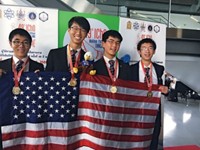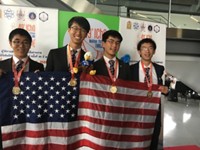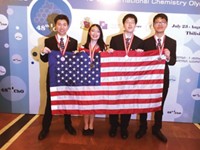Advertisement
Grab your lab coat. Let's get started
Welcome!
Welcome!
Create an account below to get 6 C&EN articles per month, receive newsletters and more - all free.
It seems this is your first time logging in online. Please enter the following information to continue.
As an ACS member you automatically get access to this site. All we need is few more details to create your reading experience.
Not you? Sign in with a different account.
Not you? Sign in with a different account.
ERROR 1
ERROR 1
ERROR 2
ERROR 2
ERROR 2
ERROR 2
ERROR 2
Password and Confirm password must match.
If you have an ACS member number, please enter it here so we can link this account to your membership. (optional)
ERROR 2
ACS values your privacy. By submitting your information, you are gaining access to C&EN and subscribing to our weekly newsletter. We use the information you provide to make your reading experience better, and we will never sell your data to third party members.
ACS News
U.S. team wins 4 golds at the International Chemistry Olympiad
Winning streak continues as high school students turn in a top performance for the second year in a row
by Tien Nguyen and Linda Wang, C&EN Washington
July 30, 2018

The U.S. continued its dominance in chemistry on the world stage this week, winning four gold medals for the second year in a row at the International Chemistry Olympiad, which began this year on July 19 in Slovakia and concluded on July 29 in the Czech Republic. China, which won the top scoring gold medal, was the only other country to win four golds this year.
“This is the highest performance we’ve ever had in this competition,” says Christine Saber, head mentor for the U.S. team and an assistant chemistry professor at Gannon University. “I could not be more proud of these students. They were equally strong in both the theory and the practical, which is what led them to be our strongest performers yet.”
The U.S. team, which is sponsored by the American Chemical Society, was made up of Yutong Dai of Princeton International School of Mathematics & Science in Princeton, N.J.; Michelle Lu of Pomperaug High School in Southbury, Conn.; Jeffrey Shi of Marcellus High School in Marcellus, N.Y.; and Andrew Wu of Park Tudor School in Indianapolis.
Shi, Lu, Wu, and Dai placed 4th, 10th, 12th, and 13th, respectively, in the gold medal category. This year, competition organizers awarded a total of 35 gold medals, 65 silver medals, and 95 bronze medals to the group of 300 high school students representing 76 countries. Each country is allowed to send up to four students to the competition.
“I think we all realized at the same time, and it was just a big shock,” says Lu of learning about her team’s accomplishment. “We were all just very very excited at that moment.”
Dai says that as soon as she learned of the results, she texted her parents, who had been eagerly waiting to hear the news. “I’m so proud that we as a team won four golds,” Dai says. “It’s so exciting.”
Shi says it was a unique experience to meet chemistry students from all over the world. “It was really interesting learning about their countries, their education systems, and how their selection process for the chemistry olympiad works. It’s really different in every country,” he says.
Wu says the team was unified in their goal of getting four gold medals this year. “We were on the same page, and we helped each other do the best that we could,” he says. “I’m really honored to be a part of such an amazing team.”
Lu says the theoretical and practical exams “touched on a lot of interesting topics that I think a lot of us had never thought about before, like DNA equilibrium. It was quite interesting to work through.”
Saber explains that the practical exam consisted of three tasks. One of the experiments involved a clock reaction that yielded a flash of blue light, which was emblematic of the competition’s logo of a “copperhead” scientist with blue hair.
The theoretical exam, Saber says, included eight tasks that involved an even mix of organic, physical, analytical, and biochemistry. One of the questions, for example, involved the synthesis of ß-caryophyllene. Another question involved the synthesis of coprine, a natural compound in mushrooms belonging to many Czech and Slovak dishes. Students were also asked to determine the crystal structure, absorption, and emission properties of Bohemian garnet.
Advertisement
Aside from the exams, students participated in excursions that introduced them to the cultures of Slovakia and the Czech Republic, such as visiting a mining museum in Slovakia, and touring Bratislava and Prague.
Mentors Michael Danahy of Bowdoin College and Silvia Atim of the University of South Carolina also accompanied the students during the trip.
This fall, Shi and Wu will be high school seniors, and Lu will be starting her junior year of high school. Dai will be starting college at Massachusetts Institute of Technology. “These students are just amazing,” Saber says. "They are our future scientists and potential Nobel laureates.”





Join the conversation
Contact the reporter
Submit a Letter to the Editor for publication
Engage with us on Twitter